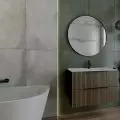The interview comes from A&B issue 03|23
Jan Mencwel - cultural animator and social activist, chairman of the City Is Ours association. For many years, with his involvement and publications, he has been proving that change and causality consists not only of what we say, but also how we say it. "Few things unite Polish women and men as much as the fight for greenery," he argues in an interview for A&B, and incidentally reveals his reflections from working on his new book.
Ania Diduch: What is worse: concrete or plastic?
Jan Mencwel: Such comparisons do not make sense. Building materials or packaging in themselves are not bad. Both of these materials will be needed by humanity all the time. The point is to point out how absurdly we abuse them, with other, less harmful solutions at our disposal. As for concrete, we are abusing it first and foremost as a pavement, and in this way we bring upon ourselves the problems I described in my book "Concrete."
Jan Mencwel, "Betonosis. How Polish cities are being destroyed" - Krytyka Polityczna Publishing House, Warsaw 2020
© Krytyka Polityczna Publishing House
Ania: Why is the subject of greenery so controversial? The fight to save trees creates a lot of conflict, aggression and unnecessarily divides instead of uniting in the name of quality.
Jan: I disagree! Few things unite Polish women and men as much as the fight for greenery. This is evident both from research, for example from the More In Common organization, which has recently started operations in Poland. But it's also confirmed by my experience as an activist and author, who toured dozens of Polish cities to talk about the book "Betonoza." If the need to protect trees and green the city generates any conflicts, it is rather on the line of residents-authorities or residents-designers. But this is a problem on the side of the authorities and on the side of the architectural industry. Both of these groups will have to adapt to the climate challenges and the associated expectations of residents. And to some extent they are already doing so.
Ania: Does concretosis have a nationality? How is Polish betonosis different from Japanese or American betonosis?
Jan: Polish concretosis differs from what happened in the United States or Japan only in that it is several decades late. Well, and the scale, because, however, we can't afford as much interference in the space of cities or the landscape as was done in those countries. But already in comparison with Europe, it can be said that we are faithfully copying the mistakes made, only three or four decades later.
Wlodawa (illustration from the book "Betonosis")
Photo: Jakub Szafranski
Ania: Is Polish concretosis a reflection of social structure? After all, nature is one of our greatest resources glorified by cultural artists in literature or painting. Is the modern escape from nature a kind of heirloom of the need for civilizational aspiration?
Jan: Nature is the most forgotten theme in Polish culture of the last few decades. Our natural landscape has disappeared from our "pantheon", it has ceased to be a subject for us. We have subordinated everything to a more undefined "development," the desire to cure our complexes and catch up with the "West." The problem is that in the matter of nature we were going backwards in development: green markets, streets, squares, forests and urban parks were something that had to be protected at all costs, because today they would constitute our development advantage over the West. So were wild rivers, swamps, marshes, scrubland - all things that seemed to us a symbol of our backwardness.
Ania: Is globalization helping to raise awareness on topics related to ecology, the climate crisis, sustainable urban planning? Or are these changes happening more from the bottom up, as in the case of initiatives like City Is Ours?
Jan: If you mean easier access to information, then yes, of course it helps. It helps a lot to show how cities in the West, which have always been a reference point and an object of envy for us, are changing today. The transformation of Paris's Champs-Élysées, which is now a major automobile thoroughfare, into an "urban garden" may be a symbol of such changes. But such things are important for the elite - the authorities or architects. Ordinary residents of Polish cities have long loved nature, want as many trees around as possible, and are furious when they are cut down. Only until recently did they not believe that "development" could look different and that they have the right to claim their rights. Today, this is fortunately changing, and I am proud to be part of that change.
Skierniewice (illustration from the book "Betonoza")
Photo: Jakub Szafranski
Ania: How were the revitalizations you describe in "Betonosis" financed? Were municipal funds supported by EU grants? If so, why didn't EU regulations force green design? Or was it simply that no one came up with the idea that the topic of vegetation as an important element of sustainable urbanism would be overlooked in Poland?
Jan: I haven't researched the financing models for these transformations in such detail, but many of them certainly received EU subsidies. Why did this happen? Because no one predicted that someone would think of it. But let's also not kid ourselves: EU policy until recently did not have so much to do with ecology. Only now, with the New Green Deal and KPO funds, this may change. Although we can already see that politicians will try to get around this by loading billions into road construction under the pretext of creating "city bypasses," but in reality new road connections between cities.
Ania: Trees in the city and the comfort of life, environmental protection and temperature for living are very important. Do you also consider the topic of nature from a more philosophical side? I think that without contact with nature we also lose contact with ourselves, and it's a domino effect that reflects in our feelings of alienation, stress, and is deferred in the decisions we make in the family or as citizens.
Jan: This is not a question of philosophy, but of science. For example, medicine. It has been known for many decades, or perhaps longer, how humans are affected by a lack of contact with nature on a daily basis. And what salutary effects this contact has. In the book, I described the example of the Children's Health Center in Warsaw, a project from the 1960s that enshrined greenery and nature as a fundamental element of patient welfare in what was then, and is still today, the leading facility in the country.
Wloclawek (illustration from the book "Betonosis")
Photo: Jakub Szafrański
Ania: What are your favorite examples of symbiosis of urban spaces in Poland and around the world?
Jan: For me the definite number 1 is the wild bank of Warsaw's Vistula River. Nowhere in the world is there such a successful project to integrate wild nature into the city's circulation. And why was it successful? Because no architect or politician had their fingers in it. I know that probably many readers are architects and will feel affected by this. So I have a request to you: go for a walk along Warsaw's Vistula River on the Praga side and tell yourself, is it possible to design something like this? In my opinion, no. Such perfect spaces can only be designed by nature, and we can at most not prevent it from doing so and make them accessible to people. That's all and that's all.
Ania: Do you conduct a private ranking of the best and worst areas in Poland in the context of the fight for trees and greenery? What would be its criteria?
Jan: I very much dislike all rankings, because it always forces simplifications. In my opinion, in every Polish city there will be both positive and negative examples. We all make the same mistakes, but we can still simply stop making them and appreciate every mature tree, every "wasteland" or wild river as something that should be absolutely protected.
Lublin (illustration from the book "Betonosis")
Photo: Jakub Szafrański
Ania: How do you find the energy to promote sustainable thinking about greenery?
Jan: It's been more than two years since the book was published, and I can see that something is changing. There are fewer and fewer cases of concretions, and none goes unnoticed. The city of Kutno, for example, which became famous all over Poland two years ago, has convinced itself of this. And there are also the first cases of cities going the other way. These are, for now, tentative attempts, such as the trees in the market square in Skierniewice or even the capital's Five Corners Square. They are not yet fully successful, but they give hope for bigger changes in the future. I know that if we don't let go, in ten years we can wake up in a much greener Poland. This is the best motivation for me to keep going.
Ania: Your new book will be published by Krytyka Polityczna in June 2023. How long have you been working on unraveling the hydrozagada?
Jan: For my own purposes - for several years. I spend a lot of time in nature, rafting with my family on Polish rivers, walking in the wetlands in the spring, watching birds. I see that water is disappearing from the Polish landscape. The question that nagged at me was why is this happening, is climate change the only cause, and if so, why is it progressing so quickly?
Concrete demolition of a section of Stalowa Street in Warsaw carried out by neighbors in September 2020, condition before
photo: archive of Jan Mencwel
Demolition of a section of Stalowa Street in Warsaw carried out by neighbors in September 2020, condition after
photo: archive of Jan Mencwel
Ania: Why did you take on the subject of water?
Jan: I have heard the question of water very often when discussing concretization. I can see that this issue interests people, that restrictions on water consumption, which are increasingly imposed in the summer, but also lower and lower river levels, raise concerns. I thought I would try to solve the mystery of the disappearance of Polish water.
Ania: What does the work on the book look like?
Jan: I had a lot of conversations with scientists and academics dealing with water, rivers, wetlands, and it was also important to travel around Poland in search of grassroots social movements that are increasingly forming around the topic of water. And in search of interesting solutions that can give hope and inspiration for the future.
Ania: Please give me one example of when working on a publication was particularly moving, nerve-wracking or completely reevaluated the point from which you started working on a report.
Jan: What surprised me the most was how the water landscape of Poland was changing. It turns out that the changes go much deeper than the last decades or even than the communist period. And the other surprise, or maybe even shock, for me was how many aspects of the drying up of Polish rivers are simply hidden from the public. The details of my investigation into this matter will be in the book "Hydrozagadka."
Ania: Thank you for the interview.





































